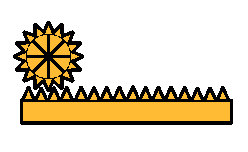Rack and Pinion: Difference between revisions
From DT Online
(Added Template) |
(Added animation) |
||
| Line 11: | Line 11: | ||
Alternatively, the rack may be fixed and the pinion rotates moving up and down the rack. This latter arrangement is used as the drive mechanism for [https://en.wikipedia.org/wiki/Rack_railway '''Funicular Railways'''] ''(steep railways up the side of hills)''. | Alternatively, the rack may be fixed and the pinion rotates moving up and down the rack. This latter arrangement is used as the drive mechanism for [https://en.wikipedia.org/wiki/Rack_railway '''Funicular Railways'''] ''(steep railways up the side of hills)''. | ||
{| | |||
|- | |||
| See '''[[2100 Animated Mechanical Mechanisms|Nguyen Duc Thang's]]''' example of a [https://youtu.be/9hI85qZ5zKA '''Rack and Pinion''']. | |||
| {{#ev:youtube|9hI85qZ5zKA|280x240|right||frame|loop=1&autoplay=1&playlist=9hI85qZ5zKA}} | |||
|} | |||
Revision as of 18:38, 25 August 2016
Description
The Rack and Pinion gear is used to convert between rotary and linear motion. Often the pinion rotates in a fixed position and the rack is free to move - this arrangement is used in the steering mechanism of most cars.
Features and Applications
Alternatively, the rack may be fixed and the pinion rotates moving up and down the rack. This latter arrangement is used as the drive mechanism for Funicular Railways (steep railways up the side of hills).
| See Nguyen Duc Thang's example of a Rack and Pinion. |
|
Click top left to enlarge |







